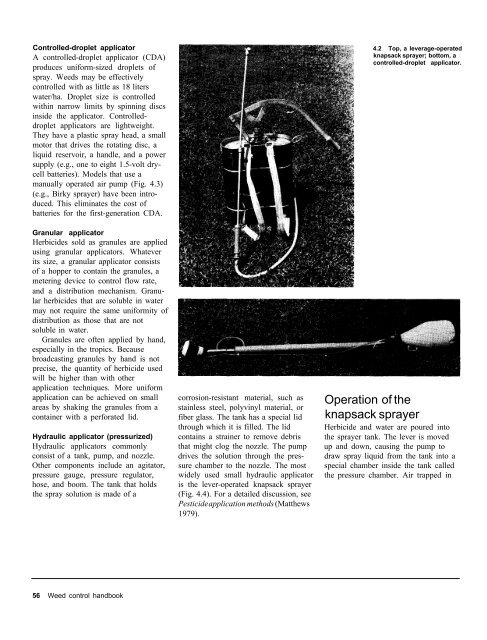A handbbok on Weed Control in Rice.pdf
A handbbok on Weed Control in Rice.pdf
A handbbok on Weed Control in Rice.pdf
You also want an ePaper? Increase the reach of your titles
YUMPU automatically turns print PDFs into web optimized ePapers that Google loves.
C<strong>on</strong>trolled-droplet applicator<br />
A c<strong>on</strong>trolled-droplet applicator (CDA)<br />
produces uniform-sized droplets of<br />
spray. <strong>Weed</strong>s may be effectively<br />
c<strong>on</strong>trolled with as little as 18 liters<br />
water/ha. Droplet size is c<strong>on</strong>trolled<br />
with<strong>in</strong> narrow limits by sp<strong>in</strong>n<strong>in</strong>g discs<br />
<strong>in</strong>side the applicator. C<strong>on</strong>trolled-<br />
droplet applicators are lightweight.<br />
They have a plastic spray head, a small<br />
motor that drives the rotat<strong>in</strong>g disc, a<br />
liquid reservoir, a handle, and a power<br />
supply (e.g., <strong>on</strong>e to eight 1.5-volt dry-<br />
cell batteries). Models that use a<br />
manually operated air pump (Fig. 4.3)<br />
(e.g., Birky sprayer) have been <strong>in</strong>tro-<br />
duced. This elim<strong>in</strong>ates the cost of<br />
batteries for the first-generati<strong>on</strong> CDA.<br />
Granular applicator<br />
Herbicides sold as granules are applied<br />
us<strong>in</strong>g granular applicators. Whatever<br />
its size, a granular applicator c<strong>on</strong>sists<br />
of a hopper to c<strong>on</strong>ta<strong>in</strong> the granules, a<br />
meter<strong>in</strong>g device to c<strong>on</strong>trol flow rate,<br />
and a distributi<strong>on</strong> mechanism. Granu-<br />
lar herbicides that are soluble <strong>in</strong> water<br />
may not require the same uniformity of<br />
distributi<strong>on</strong> as those that are not<br />
soluble <strong>in</strong> water.<br />
Granules are often applied by hand,<br />
especially <strong>in</strong> the tropics. Because<br />
broadcast<strong>in</strong>g granules by hand is not<br />
precise, the quantity of herbicide used<br />
will be higher than with other<br />
applicati<strong>on</strong> techniques. More uniform<br />
applicati<strong>on</strong> can be achieved <strong>on</strong> small<br />
areas by shak<strong>in</strong>g the granules from a<br />
c<strong>on</strong>ta<strong>in</strong>er with a perforated lid.<br />
Hydraulic applicator (pressurized)<br />
Hydraulic applicators comm<strong>on</strong>ly<br />
c<strong>on</strong>sist of a tank, pump, and nozzle.<br />
Other comp<strong>on</strong>ents <strong>in</strong>clude an agitator,<br />
pressure gauge, pressure regulator,<br />
hose, and boom. The tank that holds<br />
the spray soluti<strong>on</strong> is made of a<br />
56 <strong>Weed</strong> c<strong>on</strong>trol handbook<br />
corrosi<strong>on</strong>-resistant material, such as<br />
sta<strong>in</strong>less steel, polyv<strong>in</strong>yl material, or<br />
fiber glass. The tank has a special lid<br />
through which it is filled. The lid<br />
c<strong>on</strong>ta<strong>in</strong>s a stra<strong>in</strong>er to remove debris<br />
that might clog the nozzle. The pump<br />
drives the soluti<strong>on</strong> through the pres-<br />
sure chamber to the nozzle. The most<br />
widely used small hydraulic applicator<br />
is the lever-operated knapsack sprayer<br />
(Fig. 4.4). For a detailed discussi<strong>on</strong>, see<br />
Pesticide applicati<strong>on</strong> methods (Matthews<br />
1979).<br />
4.2 Top, a leverage-operated<br />
knapsack sprayer; bottom, a<br />
c<strong>on</strong>trolled-droplet applicator.<br />
Operati<strong>on</strong> of the<br />
knapsack sprayer<br />
Herbicide and water are poured <strong>in</strong>to<br />
the sprayer tank. The lever is moved<br />
up and down, caus<strong>in</strong>g the pump to<br />
draw spray liquid from the tank <strong>in</strong>to a<br />
special chamber <strong>in</strong>side the tank called<br />
the pressure chamber. Air trapped <strong>in</strong>











